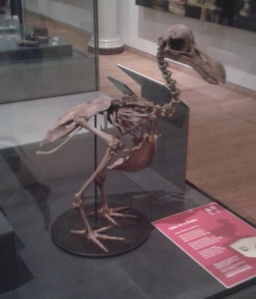RESPONSE#3 Sarah Longair
After last month’s encounter of the worlds of the Order of the Third Bird, our discussion with Catherine Richardson took a more conventional format, but with a provocative reading to start us off, it was no less stimulating. Particularly relevant to my wider research was thinking about the limitations and possibilities of early modern sources in reconstructing domestic spaces and the use, location and meaning of objects within them. In my particular area of interest, the colonial world in the 19th and 20th centuries, photographs of interiors were fashionable and common. Yet they are also misleading and the nature of the source and its production raises as many questions as the captured image of an interior setting might seem to answer.
In thinking about the dodo bones in relation to this discussion, I’m intrigued to learn more about their journey from the Mare aux Songes to UCL – the different spaces they occupied en route and the people who interacted with them. As mentioned in my last post, one line of enquiry I am pursuing focuses upon their likely collector, George Clark, an Anglican missionary school-teacher who arrived in Mauritius in 1838. Alan Grihault has drawn on Clark’s writings and those of his fellow colonial officers to tell the story of the discovery of semi-fossilised bones in this marshy area of the island in 1865.
I would like to investigate the wider context of Clark’s activities and the role of the amateur-scholar in colonial Mauritius. He was clearly a keen naturalist – how he did he deal with, store and study these prized specimens? Hundreds of bones were collected – were they kept within his house, or the Mauritius natural history society? How long did he keep them before transporting to London? Did he live amongst these objects akin to the contemporary collector of dodo remains and memorabilia Ralfe Whistler (son of ornithologist Hugh Whistler), whose house has become a shrine to these beguiling creatures?
How did Clark involve local people in this work? He wrote of ‘The astonishment of some very aged Creoles” at the discovery and their oral testimony indicates that the location of the discovery was a great surprise. Grihault draws our attention to more pressing concerns of local people – a catastrophic epidemic in Mauritius at the time had killed 1/5 of the population between 1865-68. Another source suggests Clark employed local people to wade through the marsh collecting bones.
There was evidently great demand for these specimens on the British market – how does their treatment (including the mode of handling and their location) indicate their transformation into monetarily valuable specimens? The auction house in London which received many of Clark’s bones is another location I will investigate.
While many sources are located in Mauritius, various imaginative approaches discussed at the meeting for dealing with the apparent paucity of source material present some interesting possibilities.
The most exciting dodo moment of the month was viewing the composite cast skeleton on display in Oxford. Seeing the bones assembled in this way was extremely useful for my return to the UCL specimens and I can well understand why an earlier scientist may have attempted, as discussed in my last post, to adhere the bones together. In other dodo news, two bones were up for auction in the last week – a leg with an estimated price of £7-10,000 and a pelvis at £12-15,000 – staggering sums which attest to our enduring fascination with the dodo as well as indicating their current market value in the world of contemporary collecting.


“The most exciting dodo moment of the month” definitely needs to have it’s own website!
Poor old Dodo! It’s interesting to think about the value relationship between the parts and the whole here. I’ve been grappling with that for sets of paintings too.